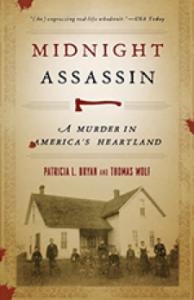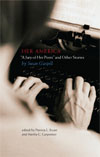Midnight Assassin
“Aficionados of the unsolved case may find a delectable example in this retelling of the little-known but gruesome murder of an Iowa farmer. Meticulously but briskly rendered mystery.”—Kirkus
“The authors use trial transcripts and period newspaper accounts to tell this story, offering not only an interesting trial drama but also a look into the social attitudes of rural America at the beginning of the twentieth century, especially toward women.”—Library Journal
“Midnight Assassin is a real-life murder mystery, to be sure. But it is also, among other things, a study of rural Iowa at the beginning of the twentieth century; a commentary on the evolving role of women; a mini-biography of Susan Glaspell, a twenty-something fledgling reporter for a Des Moines newspaper who covered the case before achieving fame as an author/feminist; and an exploration about the difficulties of learning the truth in the context of the criminal justice system. This is mini-biography at its best. This is Iowa history at its best.”—Des Moines Register
“[An] engrossing real-life whodunit.”—USA Today
“Historical whodunit devotees who have devoured all the literature on famous real-life mysteries will delight in this stirring and evocative account of an obscure turn-of-the-century Iowa murder. [The authors] vividly portray the era’s attitudes toward women (indicated by a tolerance of domestic abuse) while crafting a tale that reads like a good novel.”—Publishers Weekly, starred review
On the night of December 1, 1900, Iowa farmer John Hossack was attacked and killed while he slept at home beside his wife, Margaret. On April 11, 1901, after five days of testimony before an all-male jury, Margaret Hossack was found guilty of his murder and sentenced to life in prison. One year later, she was released on bail to await a retrial; jurors at this second trial could not reach a decision, and she was freed. She died August 25, 1916, leaving the mystery of her husband’s death unsolved.
The Hossack tragedy is a compelling one and the issues surrounding their domestic problems are still relevant today. Margaret Hossack’s composure and stoicism, developed during years of spousal abuse, were seen as evidence of unfeminine behavior, while John Hossack—known to be a cruel and dangerous man—was hailed as a respectable husband and father.
Midnight Assassin also introduces us to Susan Glaspell, a journalist who reported on the Hossack murder for the Des Moines Daily. Later these same events were used as the basis for her classic short story, “A Jury of Her Peers,” and the famous play Trifles.
Based on almost a decade of research, Midnight Assassin is a riveting story of loneliness, fear, and suffering in the rural Midwest.
For more information as well as a reader's guide, visit www.midnightassassin.com.





